NVIDIA GeForce GTX 680 Review: Retaking The Performance Crown
by Ryan Smith on March 22, 2012 9:00 AM ESTCompute: What You Leave Behind?
As always our final set of benchmarks is a look at compute performance. As we mentioned in our discussion on the Kepler architecture, GK104’s improvements seem to be compute neutral at best, and harmful to compute performance at worst. NVIDIA has made it clear that they are focusing first and foremost on gaming performance with GTX 680, and in the process are deemphasizing compute performance. Why? Let’s take a look.
Our first compute benchmark comes from Civilization V, which uses DirectCompute to decompress textures on the fly. Civ V includes a sub-benchmark that exclusively tests the speed of their texture decompression algorithm by repeatedly decompressing the textures required for one of the game’s leader scenes. Note that this is a DX11 DirectCompute benchmark.
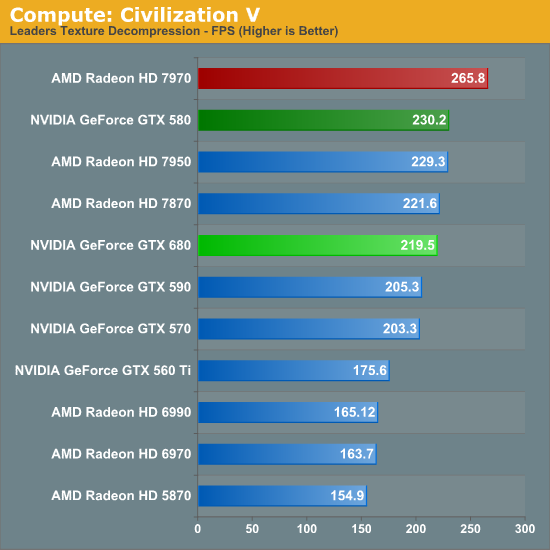
Remember when NVIDIA used to sweep AMD in Civ V Compute? Times have certainly changed. AMD’s shift to GCN has rocketed them to the top of our Civ V Compute benchmark, meanwhile the reality is that in what’s probably the most realistic DirectCompute benchmark we have has the GTX 680 losing to the GTX 580, never mind the 7970. It’s not by much, mind you, but in this case the GTX 680 for all of its functional units and its core clock advantage doesn’t have the compute performance to stand toe-to-toe with the GTX 580.
At first glance our initial assumptions would appear to be right: Kepler’s scheduler changes have weakened its compute performance relative to Fermi.
Our next benchmark is SmallLuxGPU, the GPU ray tracing branch of the open source LuxRender renderer. We’re now using a development build from the version 2.0 branch, and we’ve moved on to a more complex scene that hopefully will provide a greater challenge to our GPUs.
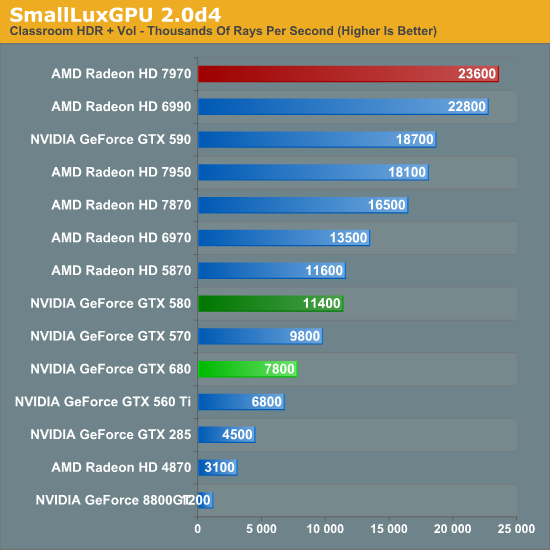
CivV was bad; SmallLuxGPU is worse. At this point the GTX 680 can’t even compete with the GTX 570, let alone anything Radeon. In fact the GTX 680 has more in common with the GTX 560 Ti than it does anything else.
On that note, since we weren’t going to significantly change our benchmark suite for the GTX 680 launch, NVIDIA had a solid hunch that we were going to use SmallLuxGPU in our tests, and spoke specifically of it. Apparently NVIDIA has put absolutely no time into optimizing their now all-important Kepler compiler for SmallLuxGPU, choosing to focus on games instead. While that doesn’t make it clear how much of GTX 680’s performance is due to the compiler versus a general loss in compute performance, it does offer at least a slim hope that NVIDIA can improve their compute performance.
For our next benchmark we’re looking at AESEncryptDecrypt, an OpenCL AES encryption routine that AES encrypts/decrypts an 8K x 8K pixel square image file. The results of this benchmark are the average time to encrypt the image over a number of iterations of the AES cypher.
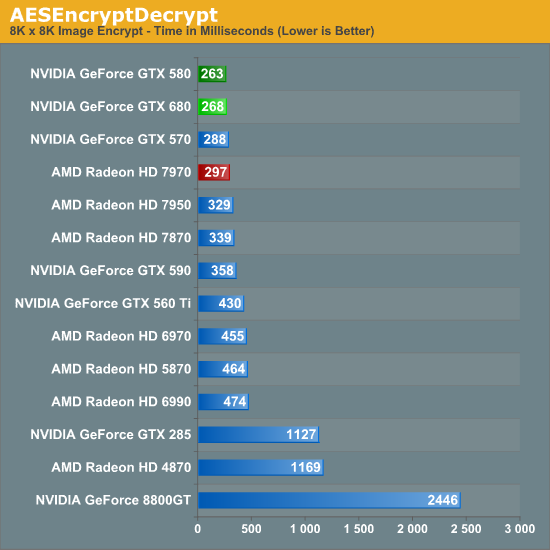
Starting with our AES encryption benchmark NVIDIA begins a recovery. GTX 680 is still technically slower than GTX 580, but only marginally so. If nothing else it maintains NVIDIA’s general lead in this benchmark, and is the first sign that GTX 680’s compute performance isn’t all bad.
For our fourth compute benchmark we wanted to reach out and grab something for CUDA, given the popularity of NVIDIA’s proprietary API. Unfortunately we were largely met with failure, for similar reasons as we were when the Radeon HD 7970 launched. Just as many OpenCL programs were hand optimized and didn’t know what to do with the Southern Islands architecture, many CUDA applications didn’t know what to do with GK104 and its Compute Capability 3.0 feature set.
To be clear, NVIDIA’s “core” CUDA functionality remains intact; PhysX, video transcoding, etc all work. But 3rd party applications are a much bigger issue. Among the CUDA programs that failed were NVIDIA’s own Design Garage (a GTX 480 showcase package), AccelerEyes’ GBENCH MatLab benchmark, and the latest Folding@Home client. Since our goal here is to stick to consumer/prosumer applications in reflection of the fact that the GTX 680 is a consumer card, we did somewhat limit ourselves by ruling out a number of professional CUDA applications, but there’s no telling that compatibility there would fare any better.
We ultimately started looking at Distributed Computing applications and settled on PrimeGrid, whose CUDA accelerated GENEFER client worked with GTX 680. Interestingly enough it primarily uses double precision math – whether this is a good thing or not though is up to the reader given the GTX 680’s anemic double precision performance.
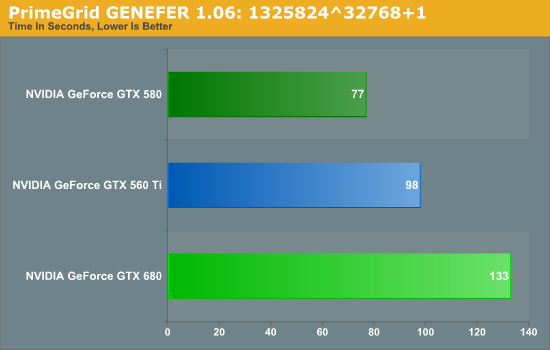
Because it’s based around double precision math the GTX 680 does rather poorly here, but the surprising bit is that it did so to a larger degree than we’d expect. The GTX 680’s FP64 performance is 1/24th its FP32 performance, compared to 1/8th on GTX 580 and 1/12th on GTX 560 Ti. Still, our expectation would be that performance would at least hold constant relative to the GTX 560 Ti, given that the GTX 680 has more than double the compute performance to offset the larger FP64 gap.
Instead we found that the GTX 680 takes 35% longer, when on paper it should be 20% faster than the GTX 560 Ti (largely due to the difference in the core clock). This makes for yet another test where the GTX 680 can’t keep up with the GTX 500 series, be it due to the change in the scheduler, or perhaps the greater pressure on the still-64KB L1 cache. Regardless of the reason, it is becoming increasingly evident that NVIDIA has sacrificed compute performance to reach their efficiency targets for GK104, which is an interesting shift from a company that was so gung-ho about compute performance, and a slightly concerning sign that NVIDIA may have lost faith in the GPU Computing market for consumer applications.
Finally, our last benchmark is once again looking at compute shader performance, this time through the Fluid simulation sample in the DirectX SDK. This program simulates the motion and interactions of a 16k particle fluid using a compute shader, with a choice of several different algorithms. In this case we’re using an (O)n^2 nearest neighbor method that is optimized by using shared memory to cache data.
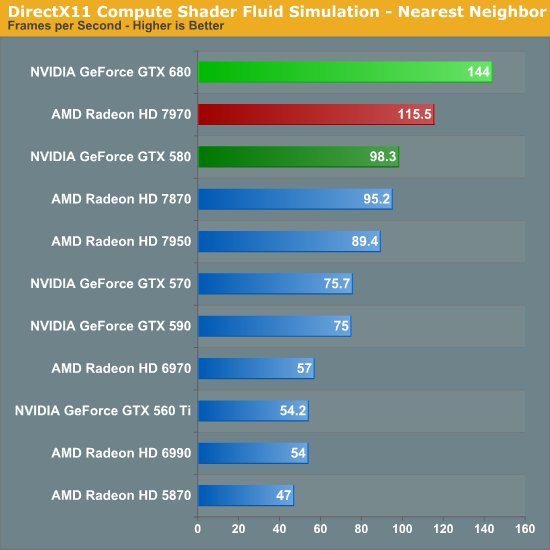
Redemption at last? In our final compute benchmark the GTX 680 finally shows that it can still succeed in some compute scenarios, taking a rather impressive lead over both the 7970 and the GTX 580. At this point it’s not particularly clear why the GTX 680 does so well here and only here, but the fact that this is a compute shader program as opposed to an OpenCL program may have something to do with it. NVIDIA needs solid compute shader performance for the games that use it; OpenCL and even CUDA performance however can take a backseat.










404 Comments
View All Comments
CeriseCogburn - Friday, March 23, 2012 - link
That's a good combo, it's high on the charts.SpeedyGonzales - Friday, March 23, 2012 - link
AMD 7970 and Nvidia 680GTX are both good cards.Nevertheless AMD and Nvidia try to push price increases for the upper midrange class, either because of the limited supply due to the new process or because they just try.
Both cards are from a die size perspective as well as from the performance vs. last generation perspective clearly $350-399 cards.
I recommend to wait, if you are not desperate. Demonstrate, that the market does not accept price increases, specifically given, that pogress of PC graphics is massively blocked by the stupid consoles.
kmmatney - Friday, March 23, 2012 - link
To those wondering how people have enough money to buy $500 tablets ....we don't buy $500 video cards. I guess we spend moneuy on what we want - I had no trouble plucking down $500 for an iPad2, but to me onlya fool would pay $500 for a video card...evilspoons - Friday, March 23, 2012 - link
At last, the replacement for my GTX 285 has arrived.It's over twice as fast. It uses less power so I can safely continue to use the same power supply. It's quieter at idle and barely louder at full tilt. It's even smaller!
AnotherGuy - Friday, March 23, 2012 - link
"the GTX 680 is faster, cooler, and quieter than the Radeon HD 7970."From the benches I saw in ur review I only see it being a little faster on more games and slower on a couple others... Also at load nVidia gets hotter than 7970... Check the Metro bench temps!
nVidia is finally using as much power as AMD compared to what it used to use before and u gotta call it quieter and cooler?
Are u just a Fanboy or u got payed to write that down?
silverblue - Friday, March 23, 2012 - link
Shh. It does use a little less power, and AMD have historically had quicker fans, which may explain why 7970 is cooler (that, and the cooler design).AnotherGuy - Friday, March 23, 2012 - link
Do you see the the temps in Metro benchmark?http://www.anandtech.com/show/5699/nvidia-geforce-...
AMD 7970 74 Celcius, nVidia 680 GTX 78 Celsius
How is nVidia cooler ?
BoFox - Monday, March 26, 2012 - link
At idle - that's how - and also when both cards are overclocked- the 7970 obviously reaches thermal limits much quicker than GTX 680 which reaches the limit of voltage feed due to lack of power phases and 8-pin PCI-E connector for clean power.Also, when overclocking HD 7970 to say, 1150MHz, it usually requires voltage tweaking. By then, it's already consuming more power than even GTX 580!
OTOH, GTX 680 still remains rather quiet and cool-running when overclocked to the max (with dynamic voltage scaling).
BoFox - Monday, March 26, 2012 - link
Why? Isn't that a good thing? Even if just a little bit, it's still true.travbrad - Tuesday, March 27, 2012 - link
"From the benches I saw in ur review I only see it being a little faster on more games and slower on a couple others... "Look at them again. The only game where the 7970 has a performance advantage greater than 2% is Crysis Warhead, which is an old game that almost no one plays anymore.
1920x1200 percentages:
Crysis:Warhead--7970 is 12% faster
Metro2033--7970 is 2% faster
Dirt3--680 is 17% faster
Shogun2---680 is 15% faster
Batman--680 is 17% faster
Portal2--680 is 22% faster
BF3--680 is 31% faster
SC2--680 is 27% faster
Skyrim--680 is 16% faster
Civ5--7970 is 1% faster
The 680 is clearly the faster card overall, and at $50 cheaper definitely the better deal.